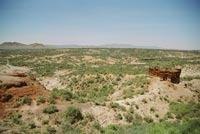Over the last thirty years or so, it has become increasingly apparent that Africa is probably the “Cradle of Mankind”. From Africa they spread out to populate the rest of Earth. Remains of the earliest humans were found in Oldupai Gorge.
 Oldupai Gorge (originally misnamed Olduvai) is the most famous archaeological location in East Africa, and has become an essential visit for travelers to Ngorongoro or Serengeti.
Oldupai Gorge (originally misnamed Olduvai) is the most famous archaeological location in East Africa, and has become an essential visit for travelers to Ngorongoro or Serengeti.At Laetoli, west of Ngorongoro Crater, hominid footprints are preserved in volcanic rock 3.6 millions years old and represent some of the earliest signs of mankind in the world. Three separate tracks of a small-brained upright walking early hominid. Australopithecus afarensis, a creature about 1.2 to 1.4 meters
 high, were found. Imprints of these are displayed in the Oldupai museum.
high, were found. Imprints of these are displayed in the Oldupai museum.More advanced descendants of Laetoli’s hominids were found further north, buried in the layers of the 100 meters deep Oldupai Gorge. Excavations, mainly by the archaeologist Louis and Mary Leakey, yielded four different kinds of hominid, showing a gradual increases in brain size and in the complexity of their stone tools. The first skull of Zinjanthropus, commonly known as ‘Nutcracker Man’ who lived about 1.75 millions years ago, was found here. The most important find include Home habilis, Zinjathropus and the Laetoli footprints.
The excavation sites have been preserved for public viewing and work continues during the dry seasons, coordinated by the Department of Antiquities. One may visit Oldupai at all times of the year. It is necessary to have official guide to visit the excavations. At the top of the Gorge there is small museum, a sheltered area used for lectures and talks, toilets and a cultural boma. Local Maasai souvenirs are also available.
Thus, Oldupai and Laetoli makes the Ngorongoro Conservation Area an important place in the world for the study of human origins and human evolution.
Discover the world as it was when we were once all African.
Visit a Modern-Day Eden.
 The Ngorongoro Conservation Area (NCA) - where people and their early ancestor have co-existed with wildlife for nearly four million years. This World Heritage Site and International Biosphere Reserve encompasses a spectacular mosaic of landscape that includes the breath-taking Ngorongoro Crater and the legendary Serengeti - the annual host of the World’s highest concentration and diversity of migratory animals numbering nearly two-million strong. As if this wasn’t enough, the NCA also contains two important and internationally-known fossil and archaeological sites: Laetoli and Olduvai Gorge. Both continue to contribute significantly to understanding of humankind’s physical, behavioral and technological evolution.
The Ngorongoro Conservation Area (NCA) - where people and their early ancestor have co-existed with wildlife for nearly four million years. This World Heritage Site and International Biosphere Reserve encompasses a spectacular mosaic of landscape that includes the breath-taking Ngorongoro Crater and the legendary Serengeti - the annual host of the World’s highest concentration and diversity of migratory animals numbering nearly two-million strong. As if this wasn’t enough, the NCA also contains two important and internationally-known fossil and archaeological sites: Laetoli and Olduvai Gorge. Both continue to contribute significantly to understanding of humankind’s physical, behavioral and technological evolution.The Olduvai Gorge Museum and Visitors Center offer numerous educational exhibits, including fossils and artifacts of our human ancestors and skeletons of many extinct animals who shared their world. There are also informative lectures, special guided archaeological sites tours, native handcrafts and a well-stocked bookshop. See and learn about our collective human origins when we were once all Africans.
The Laetoli Footprints: First Steps on the Road to Humankind
See and touch a huge cast of actual footprints made by our early human ancestors (hominins ) known as “Lucy" Australopithecus afarensis. The prints of three hominins were miraculously preserved in muddy ash deposited by volcanic eruptions and hardened by the sun some 3.6 million years ago.Made by feet little different than our own, they proved conclusively that these creatures stood and walked upright (bipedally) with a human-like stride a million years before the invention of stone tools and the initial growth in hominin brain size. It’s undoubtedly one of the most astounding and important scientific discoveries of our time.
A complete room of the Olduvai Museum devoted to the hominin footprint trail.


No comments:
Post a Comment